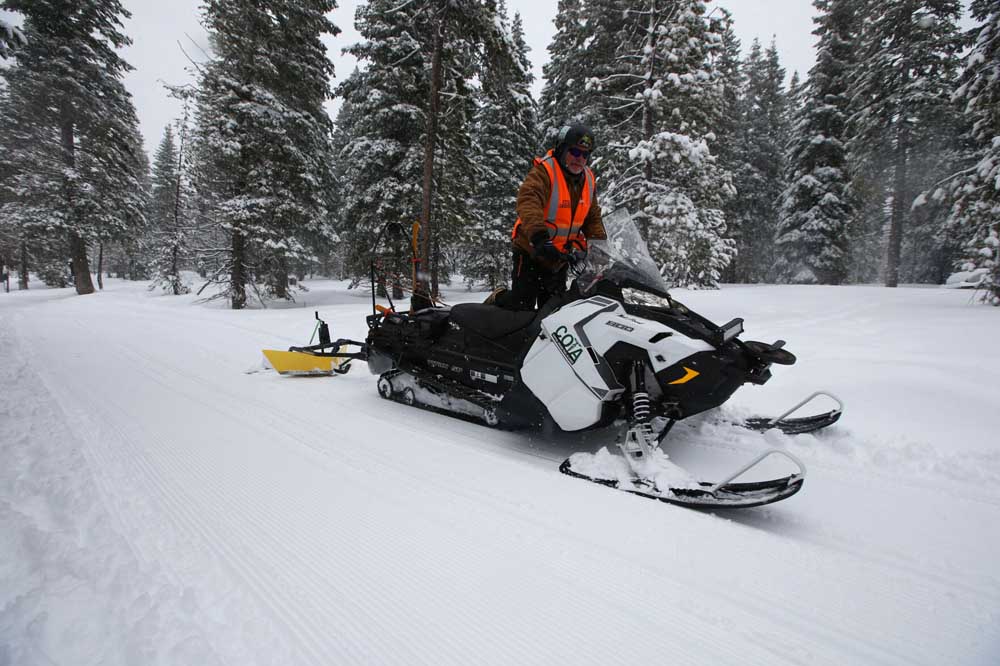Fatbiking is an ideal winter option when skiing conditions worsen
Published 8:00 am Friday, February 28, 2025

- Bend's John Molloy, who is one of the Central Oregon Trail Alliance's winter groomers, uses a snowmobile to groom the fatbike trails at Wanoga Sno-park.
Relatively warm weather this week has made for deteriorating snow conditions on the ski slopes. But a skier’s nightmare is a fatbiker’s dream. Most skiers and snowboarders loathe wet, heavy snow, but those are ideal conditions for fatbiking. Temperatures in the 50s this week should make for prime grooming and riding on the fatbike trail network at Wanoga Sno-park southwest of Bend, which includes about 10 miles of packed singletrack groomed by volunteers from the Central Oregon Trail Alliance.
Designed for packed snow
Fatbikes typically perform better on packed-down snow than on several inches of fresh powder. The bikes’ wider tires (3.8 to 5 inches wide versus 2.25 inches for standard mountain bike tires) allow for better traction in snow or sand. Central Oregonians primarily use them for riding in the snow.
John Molloy, a volunteer groomer for COTA, grooms the trails from the sno-park with a rolling groomer pulled by a snowmobile. Via a permit from the Deschutes National Forest, COTA is allowed to groom the trails each winter from Jan. 1 until there is not enough snow to groom.
Fatbikes are capable of ripping through about 2 to 3 inches of fresh snow. Anything deeper than that becomes extremely difficult, according to Molloy. Groomed trails give fatbike riders a firmer surface to avoid sinking into the snow. Tire pressure can be as low as 5 or 6 pounds per square inch on fatbikes — mountain bikes are usually between 30 and 50 PSI — to provide even more traction on challenging terrain.
Variety of options
The fatbike trails at Wanoga start across the parking lot from the sledding hill. Outer Loop is 6.2 miles and 3 PSI is 3.5 miles. An adaptive athlete ramp is located near the start of the trails in the parking lot, and the ramp is groomed and plowed.
Fatbikes are also allowed on snowshoe trails and groomed snowmobile trails in Central Oregon, but they are prohibited at Nordic ski areas such as Virginia Meissner Sno-park and the Mt. Bachelor Nordic Center.
Snowshoe loops at Swampy Lakes Sno-park and near Todd Lake are popular among fatbikers. Sometimes the cyclists themselves will snowshoe to pack the trails down for fatbiking.
Fatbikers can find other places to ride throughout the winter. In the right conditions, they can ride the regular mountain bike trails just west of Bend.
“If it’s 3 inches of new snow, it’s going to be difficult to ride any bike through,” says Gary Meyer, a longtime Central Oregon fatbiker who started grooming the Wanoga trails more than 10 years ago. “But once you start to get that 3 inches compressed a bit, then the fatbike excels and you can float on top of the snow. A skinnier tire would continue to dig a rut in it.”
Fatbikers often report trail conditions on Bendtrails.org and on the Central Oregon Fatbikes Facebook page.
Many options exist for fatbikers, but Molloy says he prefers the Wanoga trails: “It’s packed snow, you’re really the only ones out there, you can take a dog if you want. It’s just really nice.”
Fatbikers, snowshoers and cross-country skiers have all been enjoying the plentiful snow conditions this winter at Wanoga, Virginia Meissner and Swampy Lakes sno-parks, all west of Bend. Fatbikers are required to yield to snowshoers and skiers.
Meyer began grooming fatbike trails at Wanoga in the winter of 2013-14, and the sport has steadily increased in popularity over the last decade in Central Oregon. Most of the bike shops in the area now sell and rent fatbikes.





